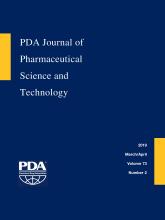Abstract
Appropriate segregation within manufacturing facilities is required by regulators and utilized by manufacturers to ensure that the final product has not been contaminated with (a) adventitious viruses, (b) another pre-/postviral clearance fraction of the same product, or (c) another product processed in the same facility. However, there is no consensus on what constitutes appropriate facility segregation to minimize these risks. In part, this is due to the fact that a wide variety of manufacturing facilities and operational practices exist, including single-product and multiproduct manufacturing, using traditional segregation strategies with separate rooms for specific operations that may use stainless steel or disposable equipment to more modern ballroom-style operations that use mostly disposable equipment (i.e., pre- and postviral clearance manufacturing operations are not physically segregated by walls). Further, consensus is lacking around basic definitions and approaches related to facility segregation. For example, given that several unit operations provide assurance of virus clearance during downstream processing, how does one define pre- and postviral clearance and at which point(s) should a viral segregation barrier be introduced? What is a “functionally closed” system? How can interventions be conducted so that the system remains functionally closed? How can functionally closed systems be used to adequately isolate a product stream and ensure its safety? To address these issues, the member companies of the Consortium on Adventitious Agent Contamination in Biomanufacturing (CAACB) have conducted a facility segregation project with the following goals: define “pre- and postviral clearance zones” and “pre- and postviral clearance materials”; define “functionally closed” manufacturing systems; and identify an array of facility segregation approaches that are used for the safe and effective production of recombinant biologics as well as plasma products. This article reflects the current thinking from this collaborative endeavor.
LAY ABSTRACT: Operations in biopharmaceutical manufacturing are segregated to ensure that the final product has not been contaminated with adventitious viruses, another fraction of the same product, or with another product from within the same facility. Yet there is no consensus understanding of what appropriate facility segregation looks like. There are a wide variety of manufacturing facilities and operational practices. There are existing facilities with separate rooms and more modern approaches that use disposable equipment in an open ballroom without walls. There is also no agreement on basic definitions and approaches related to facility segregation approaches. For example, many would like to claim that their manufacturing process is functionally closed, yet exactly how a functionally closed system may be defined is not clear. To address this, the member companies of the Consortium on Adventitious Agent Contamination in Biomanufacturing (CAACB) have conducted a project with the goal of defining important manufacturing terms relevant to designing an appropriately segregated facility and identifying different facility segregation approaches that are used for the safe and effective production of recombinant biologics as well as plasma products.
- Functionally closed
- Viral clearance
- Facility segregation
- Adventitious agent contamination
- Physical segregation
- Open ballroom
- © PDA, Inc. 2019
PDA members receive access to all articles published in the current year and previous volume year. Institutional subscribers received access to all content. Log in below to receive access to this article if you are either of these.
If you are neither or you are a PDA member trying to access an article outside of your membership license, then you must purchase access to this article (below). If you do not have a username or password for JPST, you will be required to create an account prior to purchasing.
Full issue PDFs are for PDA members only.
Note to pda.org users
The PDA and PDA bookstore websites (www.pda.org and www.pda.org/bookstore) are separate websites from the PDA JPST website. When you first join PDA, your initial UserID and Password are sent to HighWirePress to create your PDA JPST account. Subsequent UserrID and Password changes required at the PDA websites will not pass on to PDA JPST and vice versa. If you forget your PDA JPST UserID and/or Password, you can request help to retrieve UserID and reset Password below.






